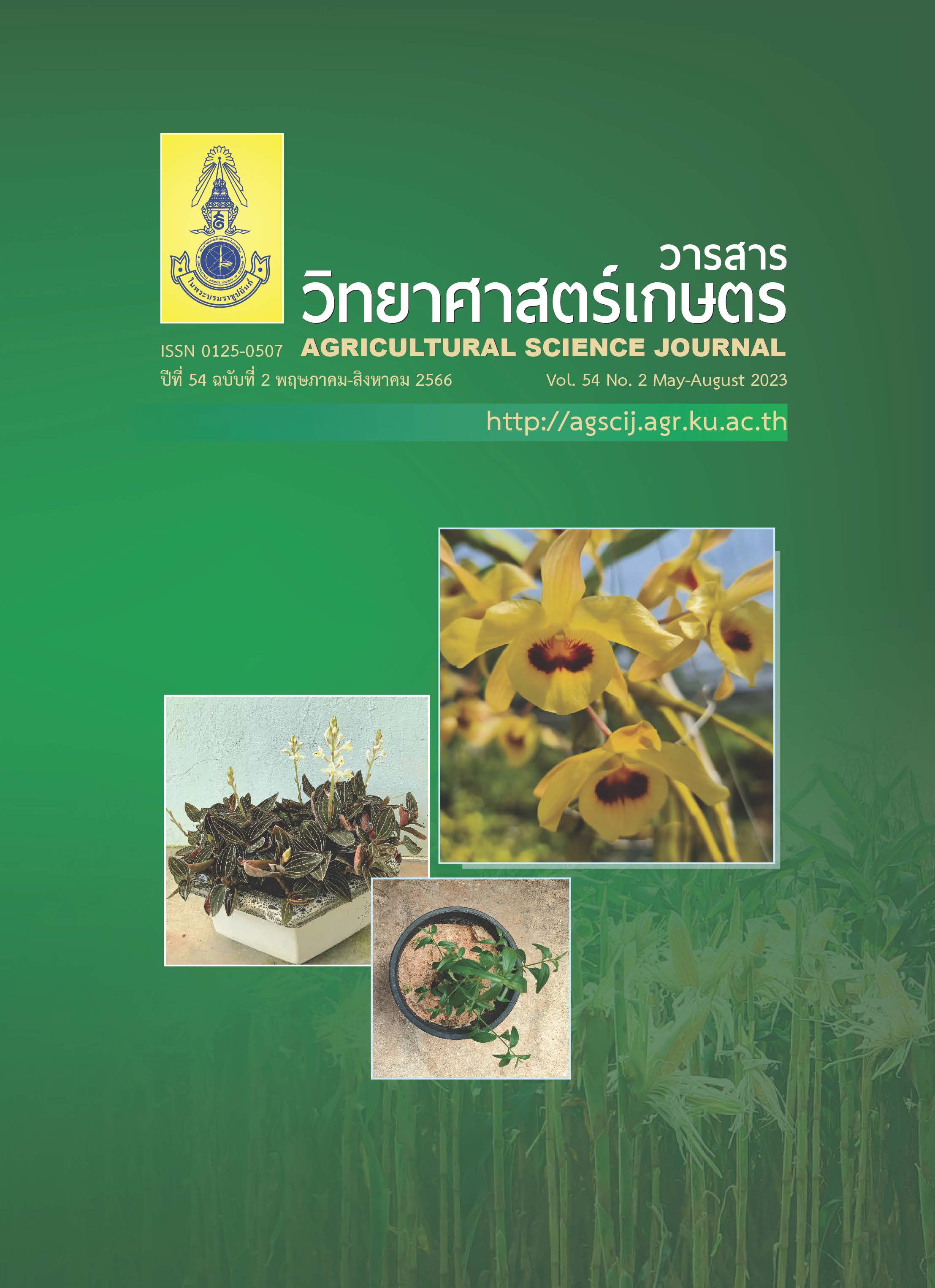Effects of Pre-emergence in Combination with Post-emergence Herbicides on Weed Control, Growth and Yield of Maize
Main Article Content
Abstract
Background and Objectives: Appropriate use of herbicides on maize reduces the toxicity on maize and creates better growth environment for maize. The research aimed to test the weed control efficiency of pre-emergence herbicide combined with post-emergence herbicide on maize inbred lines and hybrid cultivars.
Methodology: The experiment was laid out in a split plot in randomized complete block design (RCBD) with 3 replications. The main plots were 7 treatments, the pre-emergence herbicides only are atrazine + pendimethalin and compared with pre-emergence herbicide combining with post-emergence herbicides including 6 treatments; included 2,4-D dimethylammonium, glufosinate ammonium, nicosulfuron + atrazine, topramezone + atrazine, tembotrione + atrazine, and mesotrione/atrazine. The subplots were 18 inbred lines of Kasetsart University, and hybrids (SW4452, NS3, S7328, PAC339, CP888, and DK6919) which were used as comparisons.
Main Results: The pre-emergence herbicides combined with post-emergence herbicides 2,4-D dimethylammonium resulted in curled leaves symptoms in the inbred Ki48, Ki60, and Ki61. The application of glufosinate ammonium caused severe plant injury while nicosulfuron + atrazine had an efficacy to control weed for 30 days after application of more than 80% (P < 0.05) but caused plant injury on and destroyed yield of Ki48, Ki50, Ki53, Ki56, Ki57, Ki58, Ki61, Ki63, and Ki64.
Conclusions: The application of topramezone + atrazine, tembotrione + atrazine, and mesotrione/atrazine showed high efficacy in controlling weed, and the yield was not significantly different (P < 0.05).
Article Details

This work is licensed under a Creative Commons Attribution-NonCommercial-NoDerivatives 4.0 International License.
References
Bryan, T. 1977. Research Method in Weed Science. Southern Weed Science Society, Auburn, Alabama.
Changsaluk, S., S. Rungmekarat, N. Waramitr, R. Suwanmonkha and S. Lim-a-roon. 2016. Weed control with fluroxypyr in field corn plantation in Lopburi province, pp. 423–429. In Proc. the 54th Kasetsart University Annual Conference: Plants, Animals, Veterinary Medicine, Fisheries, Agricultural Extension and Home Economics, 2–5 February 2016. (in Thai)
Changsaluk, S., S. Rungmekarat, S. Srichomporn, P. Phocadate, S. Jampathong and R. Suwanmonkha. 2019. Effect of nicosulfuron to pre-commercial field corn hybrids and inbred lines. In Proc. the 14th National Plant Protection Conference, 12–14 November 2019. (in Thai)
da Silva, A.F., L. Galon, G. Concenco, I. Aspiazu, E.A. Ferreira, S.P. Tironi and A.A. da Silva. 2014. Sugarcane cultivars present differential susceptibility to herbicides ametryn and trifloxysulfuron-sodium. Aust. J. Crop Sci. 8(6): 965–972.
Department of Agriculture. 2009. Manual of Herbicides. Plant Protection Research and Development Office, Bangkok. (in Thai)
Giraldeli, A.L., G.Z. da Silva, A.F.M. Silva, G.A. Ghirardello, L.R. de Marco and R.V. Filho. 2019. Efficacy and selectivity of alternative herbicides to glyphosate on maize. Rev. Ceres. 66(4): 279–286. https://doi.org/10.1590/0034-737X201966040006.
James, T.K., A. Rahman and J. Mellsop. 2000. Weed competition in maize crop under different timings for post-emergence weed control. N. Z. Plant Prot. 53: 269–272. https://doi.org/10.30843/nzpp.2000.53.3706.
Poonpaiboonpipat, T. and M. Wachoo. 2020. Efficacy of cartain herbicides on purple nutsedge control and their toxicity on sweet corn. Naresuan Agricultural Journal. 17(1): 48–57. (in Thai)
Pornprom, T. 2017. Herbicides: Principles and Mode of Action. Chulalongkorn University Press, Bangkok, Thailand. (in Thai)
Rungmekarat, S., P. Phocadate, U. Lertsuchartwanich, S. Changsaluk and J. Romkaew. 2021. Efficacy of pre-emergence in combination with post-emergence herbicides on weed control in maize. Khon Kaen Agr. J. 49(4): 903–914. https://doi.org/10.14456/kaj.2021.81. (in Thai)
Sardana, V., G. Mahajan, K. Jabran and B.S. Chauhan. 2017. Role of competition in managing weeds: an introduction to the special issue. Crop Prot. 95: 1–7. https://doi.org/10.1016/j.cropro.2016.09.011.
Sathuwijarn, S., S. Lapbanjop, S. Choekongjak, N. Wongsuwan and C. Maneechote. 2013. Efficiency of post-emergence herbicides for weed control in maize, pp. 167–181. In Research Repost 2013. Plant Protection Research and Development Office, Department of Agriculture, Bangkok, Thailand. (in Thai)
Senseman, S.A. 2007. Herbicide Handbook. 9th edition. Weed Science Society of America, USA.
Suwanketnikom, R. 2004. Herbicides: Basics and How to Use. Kasetsart University Press, Bangkok, Thailand. (in Thai)
Tesfay, A., M. Amin and N. Mulugeta. 2014. Management of weeds in maize (Zea mays L.) through various pre and post emergency herbicides. Adv. Crop Sci. Tech. 2(5): 151. https://doi.org/10.4172/2329-8863.1000151.
Weed Science Division. 2004. Manual of Weed Control and Herbicides. Weed Science Division, Plant Protection Research and Development Office, Department of Agriculture, Bangkok, Thailand. (in Thai)


